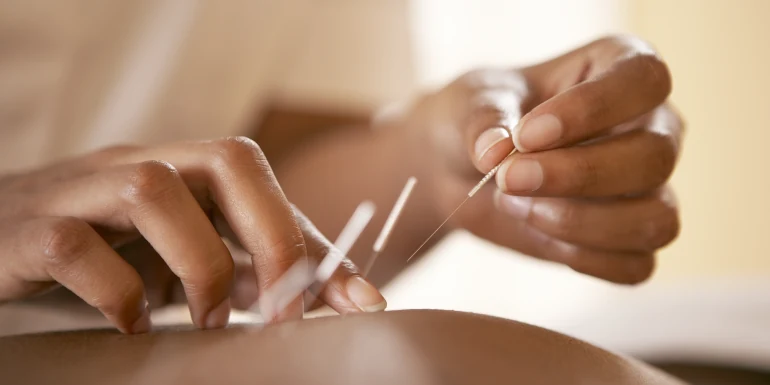
Lymphatic drainage: effects and uses
Lymphatic drainage is a type of massage that stimulates the lymphatic system. What are the benefits of lymphatic drainage and how often is it used? Find out what lymphatic drainage is used for and if there are any potential side effects.
What is lymphatic drainage?
Lymphatic drainage is a form of physical therapy that stimulates the lymphatic system. The lymphatic system is part of our body’s defence system and comprises the lymphatic organs and the system of lymphatic vessels.
Lymphatic drainage helps to remove excess fluid and waste products from the body’s tissue. The method centres on rhythmic, gentle movements performed by your therapist along the lymphatic channels. Lymphatic drainage sometimes involves using equipment, especially for draining your legs. If lymphatic drainage is performed without using equipment, it is known as manual lymphatic drainage.
Lymphatic drainage is carried out by physiotherapists, naturopaths and specially trained massage therapists. These professionals have the required expertise on the lymphatic system and the body’s anatomy.
Tip: are you looking for a suitable therapist? If so, just use our complementary therapists search.
What are the benefits of lymphatic drainage?
Lymphatic drainage improves lymph flow through targeted, gentle stimulation of the lymphatic network. Lymph is a clear fluid that flows through our body, and helps remove waste and toxins from our tissue.
Special massage movements get the lymphatic system to work more effectively. Lymphatic drainage can therefore:
- Reduce swelling and water retention: lymphatic drainage helps to remove excess fluid from your body’s tissue. This can noticeably reduce swelling and water retention, for example in your legs, arms or face.
- Support your immune system: since lymphatic drainage boosts the flow of lymph, it can help remove toxins from the body. A properly functioning lymphatic system is vital for a strong immune system. It helps fight infections and pathogens.
- Help relieve chronic complaints: lymphatic drainage can also be effective for chronic illnesses such as lymphoedema or certain rheumatic complaints. The improvement in lymphatic circulation can relieve pain and stiffness in the affected areas.
- Have a relaxing effect: the stimulation from lymphatic drainage helps relax not just the body, but also the mind. It can reduce stress and improve well-being.
Lymphatic drainage: what costs are covered by health insurance?
If lymphatic drainage is prescribed by a doctor and carried out by a physiotherapist, the costs are covered by basic insurance.
If you have SANA and COMPLETA supplementary insurance, we will cover the costs provided the therapist is recognised by Helsana.
As a general rule, you should find out which benefits your health insurance company covers before your treatment starts. We are also happy to advise you on which costs are covered.
Lymphatic drainage: which treatments are available?
Lymphatic drainage is a very versatile type of treatment and can help with a range of complaints.
Lymphatic drainage for rheumatism
Lymphatic drainage can help relieve rheumatism. This is because massage aids the removal of fluid, which helps to reduce swelling and the pain associated with it. It can also improve mobility.
This method enables rheumatism to be treated naturally.
Lymphatic drainage during pregnancy
Lymphatic drainage can reduce water retention and swelling during pregnancy. Lymphatic drainage is usually used in pregnancy in tandem with compression therapy. Whether treatment is advisable depends on how severe your condition is and how the pregnancy is progressing. You should therefore talk to your gynaecologist before undergoing treatment.
Lymphatic drainage for lymphoedema
Lymphoedema is when lymph accumulates in the body’s tissue, causing swelling. Treating lymphoedema requires intensive lymphatic drainage. Depending on how severe the symptoms are, lymphatic drainage can be performed several times a week, also combined with compression treatment, which involves wearing compression stockings and bandages.
Lymphatic drainage after an operation
Lymphatic drainage can also be beneficial after an operation (on feet or knees, for example). This is because lymphoedema can develop after an operation. Lymphatic drainage serves as oedema and decongestion therapy for oedematous (swollen) areas of the body, such as the head and neck, trunk, arms and legs. The affected area of the body swells faster and is easier to move, which helps it to heal.
Lymphatic drainage is also used following other types of injuries and operations that cause oedema (swelling). It is often prescribed by doctors after tumour treatment or lymph node removal, for example. It not only speeds up recovery, but also reduces the risk of complications.
Lymphatic drainage for legs
Lymphatic drainage is particularly effective in treating swollen legs. It aids the drainage of excess fluid and plays a key role in removing waste products from the tissue.
Lymphatic drainage forweight loss
Is lymphatic drainage useful if you want to lose weight? Yes, but only if the excess weight is caused by swelling and congestion. Lymphatic drainage on its own, however, has no direct impact on weight loss. If you want to lose weight, the important things to do are to eat a balanced diet and get enough exercise.
Lymphatic drainage for your face
Lymphatic drainage in the facial area can help with swelling. The gentle massage stimulates the flow of lymph fluid in your face and gives your skin a fresh look.
Important: please consult your doctor about possible contraindications. If you suffer from thyroid dysfunction, for example, you should avoid having lymphatic drainage in this area.
How often should you have lymphatic drainage?
How often and for how long you need lymphatic drainage can vary greatly. This is because the treatment is tailored to your individual needs. If necessary, lymphatic drainage is performed several times over a number of weeks.
Lymphatic drainage: what side effects might there be?
After receiving lymphatic drainage treatment, you may experience some side effects. These could be:
- Increased urination: this is a sign that your body is getting rid of excess fluid – a natural part of the lymphatic drainage process.
- Tiredness or drowsiness: the relaxing effect of the treatment and the detoxification of the tissue can cause tiredness. Let yourself rest after the treatment and avoid strenuous activity.
- Mild skin reactions: these reactions are generally harmless and are a result of the skin responding to the gentle stimulation. Use gentle skin care products after the treatment to soothe your skin.
- Slight pain: after receiving lymphatic drainage treatment, you may feel some slight pain. This occurs as a result of the stimulation of the tissue and the lymphatic system. This pain should be mild though, and should disappear quickly.
Listen to the messages your body is sending you. If the side effects persist or are very severe, contact your therapist or your doctor.
Lymphatic drainage is a useful complement in treating various complaints. You can also, to a certain degree, perform it yourself manually. To find out if lymphatic drainage is an option for you, you are best advised to talk to your doctor. They will clarify whether and how you could benefit from this type of treatment.

The expert provided the editorial team with advice and input for this article. Julia Pieh (doctorate in pharmacy and toxicology, pharmacist, naturopath) works in the Helsana Health Consultation Service.


Newsletter
Find out more about current health issues every month and get all the information you need about our attractive offers from all Helsana Group companies * delivered by e-mail to read whenever it suits you. Our newsletter is free of charge and you can sign up here:
We did not receive your information. Please try again later.
* The Helsana Group comprises Helsana Insurance Company Ltd, Helsana Supplementary Insurances Ltd and Helsana Accidents Ltd.